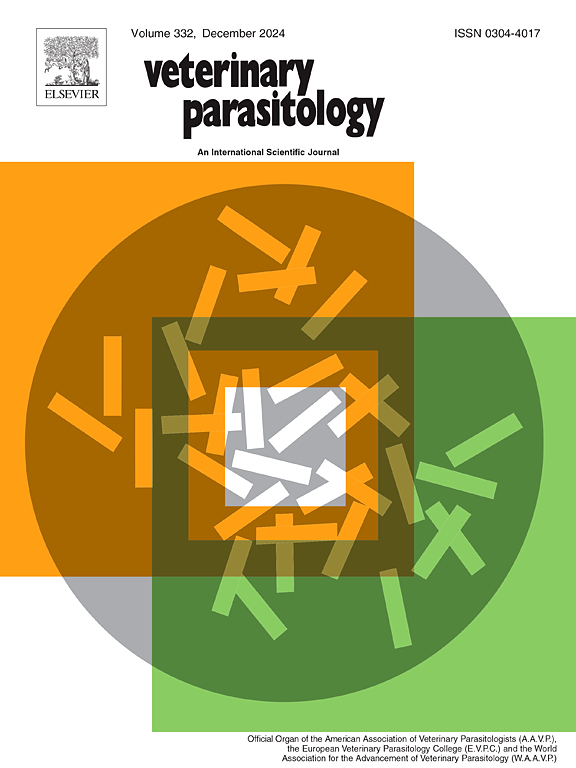Effectiveness of oral ivermectin, praziquantel, and fenbendazole against intestinal helminths in fighting birds
IF 2.2
2区 农林科学
Q2 PARASITOLOGY
引用次数: 0
Abstract
The study's objective was to evaluate the in vivo effectiveness of the combination of ivermectin + praziquantel + fenbendazole (I+P+F) against intestinal nematodes and cestodes in fighting birds. Fecal samples were taken from 181 birds to estimate the frequency of intestinal helminths. For the evaluation of anthelmintic efficacy, the birds were randomly distributed into four groups (10–19 birds/group) according to the anthelmintic evaluated: ivermectin (0.4 mg/kg orally), praziquantel (10 mg/kg orally), fenbendazole (16 mg/kg orally), and the combination of I+P+F (ivermectin 0.4 mg/kg + praziquantel 10 mg/kg + fenbendazole 16 mg/kg, orally). The effectiveness of the treatments was measured on days 0, 7, 14, and 21 post–treatments (PT). Faecal samples were taken and analyzed using Centrifugal Flotation and McMaster techniques. Overall, 33.7 % (61/181) of the birds were positive for intestinal helminths, these being Heterakis spp. (68.8 %), Capillaria spp. (55.7 %), and Raillietina spp. (54.0 %). The ivermectin and fenbendazole groups showed efficacy of 86–100 % and 66–100 %, against nematodes, respectively. The praziquantel group presented 90–100 % effectiveness for controlling Raillietina spp. The combination of I+P+F showed anthelmintic efficacy (100 %) from seven to 21 days PT against Heterakis spp., Capillaria spp., and Raillietina spp. This formulation was more effective than the individual administration of the evaluated anthelmintics in naturally infected fighting birds.
口服伊维菌素、吡喹酮和芬苯达唑对战斗鸟类肠道蠕虫的效果
本研究的目的是评估伊维菌素+吡喹酮+芬苯达唑(I+P+F)联合使用对战斗鸟类肠道线虫和绦虫的体内有效性。采集了181只鸟类的粪便样本,以估计肠道蠕虫的频率。为评价驱虫效果,根据评价的驱虫剂量随机分为伊维菌素(0.4 mg/kg口服)、吡喹酮(10 mg/kg口服)、芬苯达唑(16 mg/kg口服)和I+P+F(伊维菌素0.4 mg/kg +吡喹酮10 mg/kg +芬苯达唑16 mg/kg口服)4组(10 - 19只/组)。在治疗后第0、7、14和21天(PT)测量治疗的有效性。采用离心浮选和麦克马斯特技术采集粪便样本并进行分析。总体上,33.7% %(61/181)的鸟类肠道蠕虫呈阳性,分别为异线虫属(68.8% %)、毛线虫属(55.7% %)和细线虫属(54.0% %)。伊维菌素组和芬苯达唑组对线虫的防治效果分别为86-100 %和66-100 %。吡喹酮组对黑僵菌的防治效果为90 ~ 100% %,I+P+F联合用药对异线虫、毛线虫和黑僵菌的防治效果为100% %,对自然感染的斗鸟的防治效果优于单独用药。
本文章由计算机程序翻译,如有差异,请以英文原文为准。
求助全文
约1分钟内获得全文
求助全文
来源期刊

Veterinary parasitology
农林科学-寄生虫学
CiteScore
5.30
自引率
7.70%
发文量
126
审稿时长
36 days
期刊介绍:
The journal Veterinary Parasitology has an open access mirror journal,Veterinary Parasitology: X, sharing the same aims and scope, editorial team, submission system and rigorous peer review.
This journal is concerned with those aspects of helminthology, protozoology and entomology which are of interest to animal health investigators, veterinary practitioners and others with a special interest in parasitology. Papers of the highest quality dealing with all aspects of disease prevention, pathology, treatment, epidemiology, and control of parasites in all domesticated animals, fall within the scope of the journal. Papers of geographically limited (local) interest which are not of interest to an international audience will not be accepted. Authors who submit papers based on local data will need to indicate why their paper is relevant to a broader readership.
Parasitological studies on laboratory animals fall within the scope of the journal only if they provide a reasonably close model of a disease of domestic animals. Additionally the journal will consider papers relating to wildlife species where they may act as disease reservoirs to domestic animals, or as a zoonotic reservoir. Case studies considered to be unique or of specific interest to the journal, will also be considered on occasions at the Editors'' discretion. Papers dealing exclusively with the taxonomy of parasites do not fall within the scope of the journal.
 求助内容:
求助内容: 应助结果提醒方式:
应助结果提醒方式:


